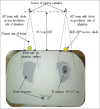Dose Shadowing and Prosthesis Involvement for Megavoltage Photon In vivo Diode Dosimetry
- PMID: 31908384
- PMCID: PMC6936197
- DOI: 10.4103/jmp.JMP_59_19
Dose Shadowing and Prosthesis Involvement for Megavoltage Photon In vivo Diode Dosimetry
Abstract
Aim: The aim of the study is to investigate the photon beam perturbations induced by an in vivo diode in combination with prosthesis involvement in a human-like phantom.
Materials and methods: Beam perturbations for 6 MV and 10 MV photons caused by an EDP-203G in vivo diode in combination with prosthesis involvement were studied in a unique water-equivalent pelvic phantom, equipped with bony structures and Ti prosthesis using single fields between 2 × 2 and 15 cm × 15 cm as well as 10 MV lateral opposing fields and a four-field plan. Dose distributions were measured with Gafchromic EBT3 films with and without the diode included in the beams on the prosthesis (prosthetic fields) and non-prosthesis (non-prosthetic fields) sides of the phantom. Differences between prosthetic and non-prosthetic field dose data were determined to assess the effect of the prosthesis on the diode-induced beam perturbations inside the phantom.
Results: Photon beam dose perturbations ranged from 2% to 7% and from 5% to 12% for prosthetic and non-prosthetic fields, respectively, with relative differences between 2% and 4%. In addition, d50 depths ranging from 8.7 to 11.5 cm and from 11.5 to 15 cm were acquired in the phantom for prosthetic and non-prosthetic fields, respectively, with relative differences between 2% and 5%.
Conclusion: On the basis of accuracy requirements in radiotherapy noting that a small underdose to tumors could yield a decrease in the probability of tumor control, the diode-induced beam perturbations in combination with prosthesis involvement in the photon fields may affect treatment outcome, as there would be a reduction in the prescribed target dose during treatment delivery.
Keywords: Beam perturbations; in vivo diode; pelvic phantom; photons; prosthesis.
Copyright: © 2019 Journal of Medical Physics.
Conflict of interest statement
There are no conflicts of interest.
Figures






Similar articles
-
Dose comparison between Gafchromic film, XiO, and Monaco treatment planning systems in a novel pelvic phantom that contains a titanium hip prosthesis.J Appl Clin Med Phys. 2017 Sep;18(5):162-173. doi: 10.1002/acm2.12141. Epub 2017 Jul 25. J Appl Clin Med Phys. 2017. PMID: 28741892 Free PMC article.
-
Dosimetry of oblique tangential photon beams calculated by superposition/convolution algorithms: a Monte Carlo evaluation.J Appl Clin Med Phys. 2010 Nov 3;12(1):3424. doi: 10.1120/jacmp.v12i1.3424. J Appl Clin Med Phys. 2010. PMID: 21330989 Free PMC article.
-
A novel method for the determination of field output factors and output correction factors for small static fields for six diodes and a microdiamond detector in megavoltage photon beams.Med Phys. 2019 Feb;46(2):944-963. doi: 10.1002/mp.13318. Epub 2018 Dec 24. Med Phys. 2019. PMID: 30521073 Free PMC article.
-
Clinical experience with routine diode dosimetry for electron beam radiotherapy.Int J Radiat Oncol Biol Phys. 2000 Nov 1;48(4):1259-65. doi: 10.1016/s0360-3016(00)00763-x. Int J Radiat Oncol Biol Phys. 2000. PMID: 11072187
-
An Experimental Slope Method for a More Accurate Measurement of Relative Radiation Doses using Radiographic and Radiochromic Films and Its Application to Megavoltage Small-Field Dosimetry.J Med Phys. 2019 Jul-Sep;44(3):145-155. doi: 10.4103/jmp.JMP_17_19. J Med Phys. 2019. PMID: 31576063 Free PMC article.
Cited by
-
Selective de-implementation of routine in vivo dosimetry.J Appl Clin Med Phys. 2023 Jul;24(7):e13953. doi: 10.1002/acm2.13953. Epub 2023 Mar 6. J Appl Clin Med Phys. 2023. PMID: 36877712 Free PMC article. Review.
References
-
- Howlett S, Duggan L, Bazley S, Kron T. Selective in vivo dosimetry in radiotherapy using P-type semiconductor diodes: A reliable quality assurance procedure. Med Dosim. 1999;24:53–6. - PubMed
-
- Oliveira FF, Amaral LL, Costa AM, Netto TG. In vivo dosimetry with silicon diodes in total body irradiation. Radiat Phys Chem. 2014;95:230–2.
-
- Alecu R, Feldmeier JJ, Alecu M. Dose perturbations due to in vivo dosimetry with diodes. Radiother Oncol. 1997;42:289–91. - PubMed
-
- Sen A, Parsai EI, McNeeley SW, Ayyangar KM. Quantitative assessment of beam perturbations caused by silicon diodes used for in vivo dosimetry. Int J Radiat Oncol Biol Phys. 1996;36:205–11. - PubMed

